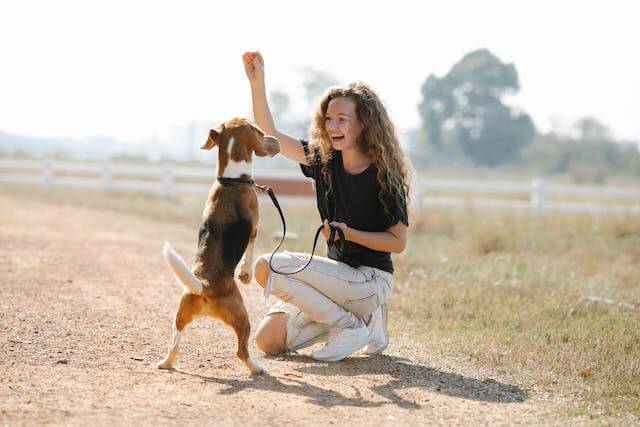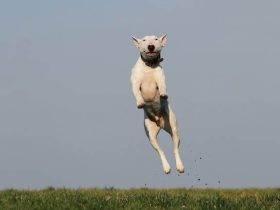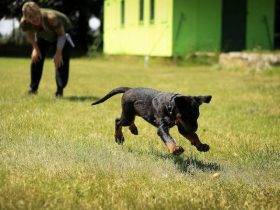Reactive dog training can be challenging but is extremely rewarding when done effectively. This article will provide an overview of what reactive dog training entails, why dogs become reactive, and the most successful training techniques backed by positive reinforcement. By understanding the root causes of reactivity and using humane training methods, dog owners can help their reactive dogs feel more comfortable and in control in potentially stressful situations.
What is Reactivity and Why Do Dogs Become Reactive?
A reactive dog displays fear, anger, or aggression towards people, animals, or objects in their environment. There are usually underlying reasons why a dog develops reactivity rather than it simply being a behavioral issue. Some of the most common causes of reactivity include:
-
Genetics –
Just like people, some dogs have a genetically stronger flight or fight response than others which can predispose them to be more fearful or anxious in new situations.
2. Lack of early socialization –
Puppies need positive experiences meeting people and other dogs from a young age to help them feel comfortable as adults. Missing this important socialization period can result in uncertainty or fearfulness.
3. Negative past experiences –
Getting scared or hurt at some point, such as being attacked by another dog or receiving rough handling from a person, may cause fear-based reactivity.
4. Overstimulation –
Factors like loud noises, large crowds or busy environments can easily overwhelm a dog who is already anxious or fearful, triggering a reactive response.
5. Lack of confidence –
Without proper training and leadership from their owner, some dogs lack self-assurance and feel they always need to be on guard, ready to respond to perceived threats.
Understanding why a dog is reactive on an individual basis is important to address the root cause of the issue rather than just the symptoms. With the right positive-reinforcement approach, dogs can learn to feel safer and more in control.
Positive Reinforcement Techniques for Reactive Dog Training
There are several evidence-based techniques that focus on positive reinforcement to help habituate reactive dogs to their triggers while building their confidence:
Counterconditioning and Desensitization – These involve carefully exposing the dog to whatever triggers their reactivity (other dogs, people, noises etc.) in a very gradual, controlled way from a distance the dog finds tolerable. As they learn positive associations with the trigger, it loses its fear-inducing power. Clicker training can help mark and reward small successes.
BAT (Behavior Adjustment Training) – This focuses on keeping the dog under threshold where it doesn’t react by retreating at the first sign of stress and rewarding calm behavior. Distance is gradually decreased over multiple sessions until the dog can handle being much closer.
BAT (Behavior Adjustment Training) – This focuses on keeping the dog under threshold where it doesn’t react by retreating at the first sign of stress and rewarding calm behavior. Distance is gradually decreased over multiple sessions until the dog can handle being much closer.
MAT (Manner Adjustment Training) – Encourages dogs to remain by your side through positive reinforcement by rewarding eye contact, loose leash walking and calm greetings with people. Used alongside counterconditioning to build a dog’s confidence.
LAT (Look at That) – Teaches dogs to shift their focus to their owner when seeing triggers by rewarding attention on command. Over time, dogs can learn to remain calm even when noticing other dogs or people.
Focusing on creating a positive association with triggers, keeping a dog under threshold, rewarding calm behavior and building confidence are key principles that align reactive training with our canine companions’ learning styles and welfare. With patience and consistency, remarkable progress can be made.
Potential Pitfalls to Avoid with Reactive Dog Training
While positive reinforcement is powerfully effective for reactivity cases, there are some common mistakes owners should try to sidestep:
Exposing dogs to triggers too quickly – Gradually increasing exposure over many sessions based on the individual dog’s comfort level is safest. Forcing interactions when a dog seems anxious can backfire.
Using punitive techniques like leash jerks or verbal reprimands – This will likely increase fearfulness or cause fallout behaviors. Positive reinforcement alone works best.
Having unrealistic expectations of speedy results – Reactivity takes time to resolve as underlying causes need addressing. Celebrate small wins and stick with it for the long haul.
Relying only on reactive training in isolation – Also focus on building confidence and training commands helps balance out anxiety and gain better leadership.
Losing focus during training – Stay attentive, calm and reward each good moment to maximize success. Being tense ourselves transfers to dogs.
Having multiple long sessions close together – Short 5-10 minute sessions spaced throughout the day lead to better retention than marathon training runs.
With care taken to avoid these common mistakes, reactive training results can still come alongside building a strong, trusting bond between owner and dog. Progress happens step by step.
Other Canine Body Language and Techniques to Improve Reactivity
Recognizing subtle signs of stress in dogs and being able to read body language is an important skill for reactive dog owners. Some indicators include:
Lip licking – A sign of unease or uncertainly they show right before becoming anxious.
Avoidance eye contact – Dogs stare to threaten while averting eyes signals they feel uncomfortable.
Yawning – Often a self-calming behavior when feeling over threshold or threatened.
Whale eye – Exposing the white part of the eyes without direct eye contact shows wariness.
Freezing or stiffening up – Dogs brace themselves when feeling unsure how else to respond.
Being able to identify when dogs are growing wary lets owners distance them before a reaction occurs. It also helps build awareness of leadership cues to defuse tension, such as:
Using upbeat, positive tones rather than tense voices when training.
Employing calming signals like looking away, covering the mouth or yawning themselves to transfer confidence.
Guiding dogs away from triggers using treats or toys for rewards instead of force from leashes.
Blocking dogs behind your body for protection if needed which signals you have control of a situation.
These techniques help dogs better handle stress while reinforcing owners as fair leaders focused on safety and care over punishment. Combined with the right positive reinforcement strategies, understanding canine body language is key to long term reactive dog success.
Preventing Relapses and Maintaining Training Progress
While dedication to regular training helps most reactive dogs make gains, slips in progress can still occur from changes in routines, unexpected events, or dogs misinterpreting triggers again at times. Some ways to reduce chances of relapse include:
Continuing exposure training for life to reinforce confidence over triggers.
Not over-praising or allowing play around triggers which confuses dogs versus calm interactions.
Making adjustments slowly if moving or encountering new situations, people or animals to avoid overwhelm.
Having backup plans like U-turns or treats during walks if reactive triggers emerge unexpectedly.
Staying vigilant of signs stress may be mounting again so it can quickly be addressed through distance and positive reinforcement of calm behaviors.
With vigilance, preventative maintenance, reasonable expectations and compassion, reactive dogs who have put in training work can maintain calmness as lifelong learners handled through care instead of fear or force. Understanding reactivity as an ongoing journey helps owners support canine companions at each step.
Conclusion
Properly addressing the root causes of reactivity through science-based, positive reinforcement training techniques is the most effective way to help fearful or anxious dogs gain confidence and learn to remain calm in difficult situations. By taking a patient, reward-focused approach, knowing how to identify stress cues and recognizing potential pitfalls, long term progress is achievable. With commitment, understanding between owners and dogs grows as triggers become less threatening through compassion instead of punishment. Both human and canine benefit tremendously through this shared journey.





Leave a Reply